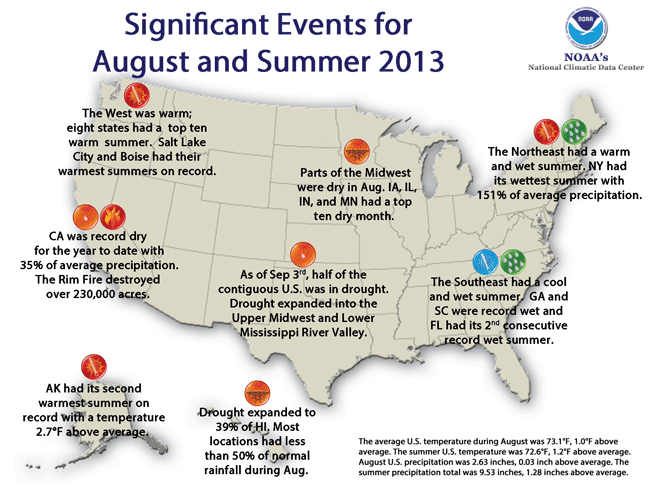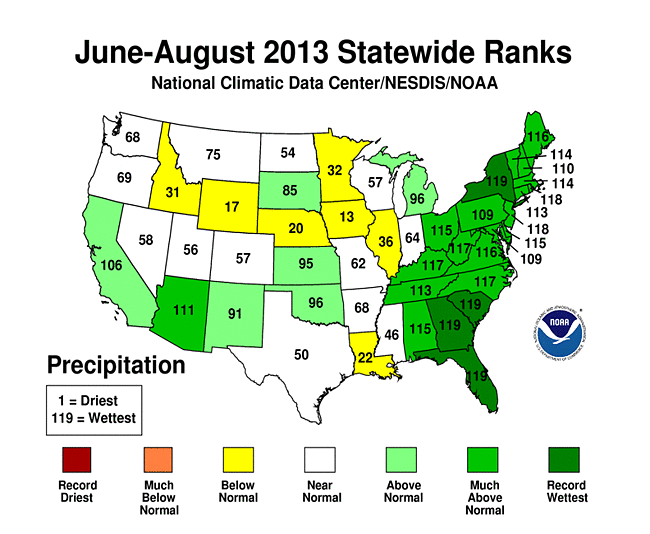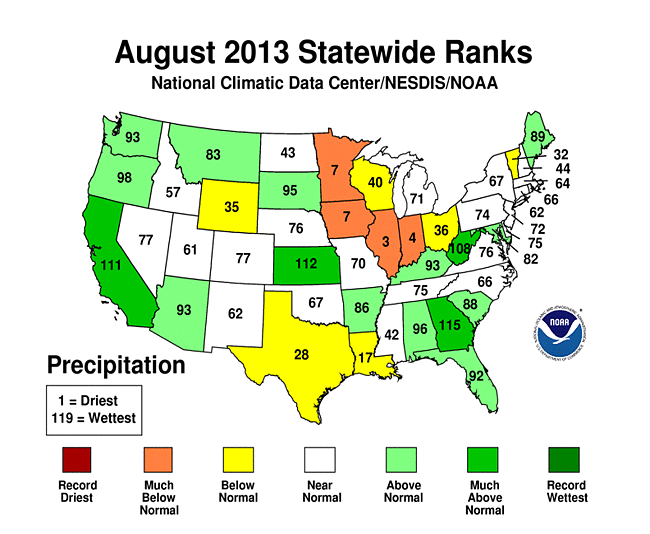Monthly Report Summary Information
The Monthly Report Summary Information is a synopsis of the collection of national and global summaries released each month.
National Summary Information - August 2013
See Full Report
Contiguous U.S. had eighth wettest and 15th warmest summer
Nation had wettest summer since 2004; Warmth dominated West and Northeast; Alaska had its second warmest summer
The average temperature for the contiguous U.S. during the summer season (June-August) was 72.6°F, 1.2°F above the 20th century average. The August temperature was 73.1°F, 1.0°F above the 20th century average — the 28th warmest such month on record for the Lower 48.
The total summer precipitation averaged across the contiguous U.S. was 9.53 inches, 1.28 inches above average and the wettest summer since 2004. The August national precipitation total was slightly above average at 2.63 inches.

Significant climate events for August 2013.
Click image to enlarge, or click here for the National Overview.
Note: The August Monthly Climate Report for the United States has several pages of supplemental information and data regarding some of the weather/climate events from the month, summer, and year-to-date.
U.S. climate highlights: summer (June-August)
- The West and parts of the Northeast were much Washington, had seasonal temperatures that ranked among the ten warmest on record. In the Northeast, four states had one of their 10 warmest summers on record.
- Below-average summer temperatures were observed in the Southeast and parts of the Ohio Valley, but no state had summer temperatures ranking among the 10 coolest.
- The Alaska statewide average summer temperature was 2.7°F above the 1971-2000 average and ranked as the second warmest summer in the 96-year period of record for the state. The warmest June-August occurred in 2004 when the statewide temperature was 4.1°F above average.
- Arizona had its ninth wettest summer on record.
- The components of the U.S. Climate Extremes Index (USCEI) that examine extremes in 1-day precipitation totals and warm night time temperatures ranked as the third and fourth highest on record for the summer season, respectively. When combining all components of the USCEI, the index was above average for June-August. The USCEI is an index that tracks the highest and lowest 10 percent of extremes in temperature, precipitation, tropical cyclones, and drought across the contiguous United States.
U.S. climate highlights: August
- The western U.S, particularly the Northwest, was Wyoming had its third warmest August, with a temperature of 67.8°F, 3.7°F above average.
- Below-average temperatures stretched from the Central Plains, through the Ohio Valley, and along most of the Eastern Seaboard, but no state had August temperatures ranking among the ten coolest.
- Both Minnesota each had a top ten dry month.
- According to the September 3rd U.S. Drought Monitor report, 50.1 percent of the contiguous U.S experienced drought conditions, up 4.5 percent since the end of July. Drought conditions expanded into the Upper Midwest and Lower Mississippi River Valley, as well as Hawaii. Beneficial rainfall helped to improve, but not eliminate, drought conditions across the Central and Southern Plains.
U.S. climate highlights: year-to-date (January-August)
- The year-to-date contiguous U.S. temperature was 54.5°F, 0.6°F above the 20th century average and was the 34th warmest January-August on record. Below-average temperatures stretched from the Upper Midwest, through the Mississippi River Valley, and into the Southeast.
- The year-to-date contiguous U.S. precipitation total of 21.77 inches was 1.57 inches above average and was the 18th. wettest January-August on record. However, rainfall was not evenly distributed across the country. wet precipitation extremes were observed in the East.
- California, Idaho, Nevada, and Oregon each had a top 10 dry year-to-date period. California's precipitation total of 5.08 inches was record low for the eight-month period at 9.54 inches below average, and 1.27 inches less than the previous record dry January-August of 1898.
- Michigan had 27.62 inches of precipitation, 7.07 inches above average — both states experienced a record wet January-August.
- For the year-to-date period, when all components of the USCEI are combined the index was near average for January-August; however, for the components of the USCEI that examine extremes, the 1-day precipitation totals ranked seventh highest and the spatial extent of drought ranked ninth highest.
 NOAA's National Centers for Environmental Information
NOAA's National Centers for Environmental Information



